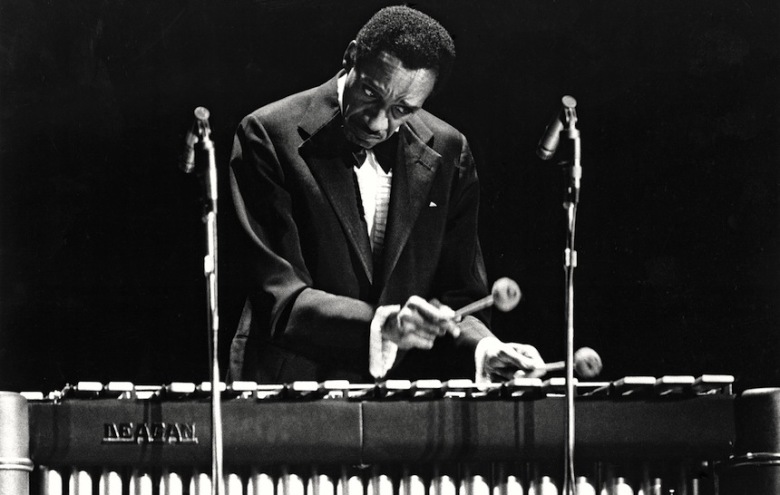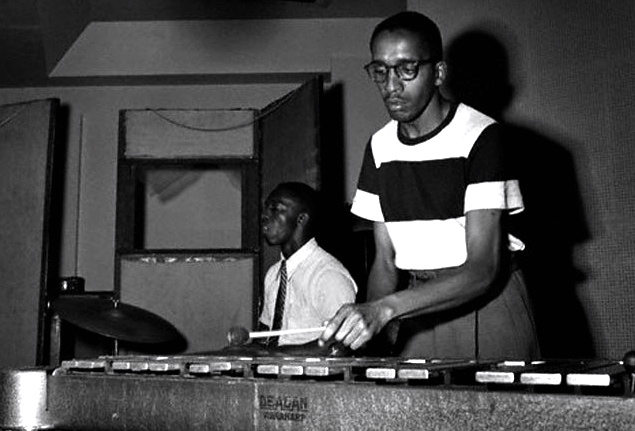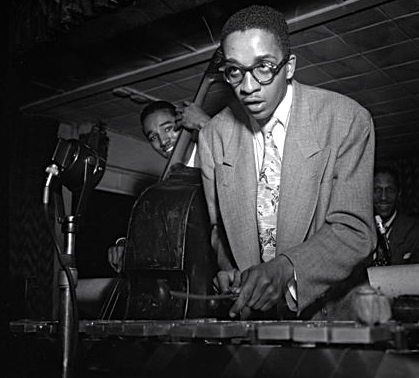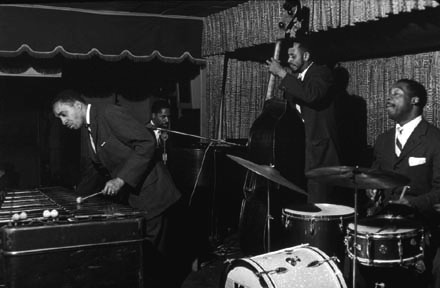
Milton “Bags” Jackson was born on January 1,1923 in Detroit, Michigan and passed away on October 9, 1999 in New York City.
Milt came from a family of six children. Milt’s mother was a pious woman who was a devout member of the church, and his father was a talented amateur musician. In his early years, Milt sang in church and realized from an early age that music had a powerful effect on him.
When Jackson was seven years old he began to study the guitar. At age eleven, he began to play the piano as well. Upon entering Miller High School, Milt began to play the drums, xylophone and sing in the school’s glee club. When he was sixteen years old, Milt’s music teacher Mr. Goldberg persuaded the young man to give the vibraphone a try. Through his teens, Jackson gained valuable performing experience in a local gospel and dance groups.
At the time, Jackson had few idols on the vibraphone, following the examples instead set by the leading horn players involved in modern jazz. Milt had seen Lionel Hampton at Detroit venues such as the Michigan State Fairgrounds and the Graystone Ballroom, which further motivated him to study the vibes. However, while Jackson appreciated Hampton’s accomplishments, he chose not to emulate him but rather to find his own voice on the instrument. Milt found his inspiration in the burgeoning bebop movement, and wished to play the vibes like the innovators of bebop.
In 1942, Jackson was drafted into the military, which derailed his plans to join the band of pianist Earl Hines. Milt returned to Detroit in 1944 after being discharged from the military and formed an ensemble entitled The Four Sharps, which featured pianist Willie Anderson, bassist Miller Clover and guitarist Emmit Flay.

In The Four Sharps, Jackson was a multi-instrumentalist performing on guitar, piano vibes and singing as well. Around this time, Milt received the nickname Bags, which he was given due to the bags under his eyes after his late night partying. During the 1940s, Detroit was receiving a lot of attention in the jazz community with its vibrant roster of talent including saxophonist Teddy Edwards, trumpeter Howard McGhee, bassist Al McKibbon, and drummer Elvin Jones.
In 1945, trumpeter Dizzy Gillespie hired Jackson for an engagement at the Billy Berg’s club in Los Angeles. Dizzy discovered Milt at a jam session in Detroit and was struck by his technical prowess. Milt became a member of the group as a probable replacement for alto saxophonist Charlie Parker,who was erratic at best in his ability to show up for gigs. Milt received a lot of exposure upon joining the Gillespie group and helped the group become the era’s leading modern jazz ensemble.
Jackson joined the Gillespie group for an engagement at the Spotlite club in New York City in March of 1945. Also in the group were bassist Ray Brown, pianist Al Haig and drummer Stan Levey. While the group’s personnel changed over the next months, Jackson remained a trusted member of the group. Jackson would later state that Gillespie’s philosophy on music and life offered a more evolved mindset in the progression of jazz.
Two months after the engagement at the Spotlite, Jackson played piano on the group’s big band recording of composer Tadd Dameron’s Our Delight and played vibes on the song Things To Come. The following year, Milt joined the group on Anthropology, A Night In Tunisia, and 52 Street Theme, which have since become jazz standards. Jackson also recorded Oop Bop Sh’Bam, That’s Earl, and One Bass Hit with former Gillespie saxophonist and drummer Kenny Clarke.
In 1947, Jackson left the Gillespie group and began a professional relationship with pianist Thelonious Monk. With Monk, Milt recorded steadily for Blue Note over the next two years. Accompanied by bassist John Simmons and drummer Shadow Wilson, Jackson and Monk recorded the songs Evidence, Mysterioso, Epistrohy, and I Mean You in 1948. A few years later, Jackson and Monk recorded Ask Me Now, Criss Cross, Four In One and with McKibbon and drummer Art Blakey.
 In 1949, Jackson joined bandleader Woody Herman and began touring with him. Along with Herman’s small ensemble, The Woodchoppers, Milt performed at the Tropicana in Havana, Cuba. After the audience was left indifferent by the ensemble’s contemporary repertoire, Woody asked Milt to play some popular standards in order to appease the audience.
In 1949, Jackson joined bandleader Woody Herman and began touring with him. Along with Herman’s small ensemble, The Woodchoppers, Milt performed at the Tropicana in Havana, Cuba. After the audience was left indifferent by the ensemble’s contemporary repertoire, Woody asked Milt to play some popular standards in order to appease the audience.
From 1951 to 1952, Milt began to record with Gillespie where he met guitarist Kenny Burrell. The rhythm section of Gillespie’s band included Brown, pianist John Lewis and drummer Kenny Clarke. The four men soon left the Gillespie group and formed their own group entitled The Modern Jazz Quartet also known as the MJQ.
In 1952, Percy Heath replaced Brown as the MJQ’s bassist, and the band began to perform. Lewis acted as the band’s musical director who began to write songs that easily blended jazz with classical-based sensibilities, which acted as a great contrast to the more blues-based songs that Milt would write.
All through the 1950s, Jackson performed with the MJQ and simultaneously recorded as a solo artist. Milt collaborated with saxophonists Coleman Hawkins and Jimmy Heath and trumpeters Art Farmer and Harry “Sweets” Edison. In 1954, Milt appeared on trumpeter Miles Davis’s album Bag’s Groove, which took the vibist’s nickname, “Bags,” for its title.
In 1959, Milt and saxophonist John Coltrane recorded the album Bags And Trane, Featuring pianist Hank Jones, bassist Paul Chambers, and drummer Connie Kay, the album would be the only joint venture between the two men. On Three Little Words, Coltrane influences Jackson as evident by the harmonic complexity during his solos. The two men truly complement each other and achieve a perfect balance between the two instruments.
In the late 1950s and early 1960s, Milt continued to collaborate with several artists including pianist Ray Charles. In 1961, Milt recorded the album Bags Meets Wes! withguitarist Wes Montgomery, pianist Wynton Kelly and drummer Philly Joe Jones.
In 1962, the MJQ released the album Lonely Woman on Atlantic Records. The group took up the hard task of recording a cover of saxophonist Ornette Coleman’s Lonely Woman. The group does an excellent job of reinterpreting the song, with Milt adding subtle nuances that changes the feel of the original while maintaining its original melodic motifs.
 In 1972, Jackson released the album Sunflower on the Columbia/Legacy label. The album featured the top talent of the time including trumpeter Freddie Hubbard, pianist Herbie Hancock,bassist Ron Carter and drummer Billy Cobham. On People Make The World Go -Round, Milt employs several sophisticated lines that fit perfectly with the funky feel of the song. With the addition of Carter’s and Hancock’s groove, Milt’s performance in all the more lively and infectious.
In 1972, Jackson released the album Sunflower on the Columbia/Legacy label. The album featured the top talent of the time including trumpeter Freddie Hubbard, pianist Herbie Hancock,bassist Ron Carter and drummer Billy Cobham. On People Make The World Go -Round, Milt employs several sophisticated lines that fit perfectly with the funky feel of the song. With the addition of Carter’s and Hancock’s groove, Milt’s performance in all the more lively and infectious.
In 1974, the MJQ broke up with Milt citing financial difficulties as his reason. The breakup enabled Milt to follow his solo career. In 1975, Milt signed with Pablo Records and made numerous appearances at the Montreaux Jazz Festival. In 1978, Milt released the album Soul Believer, which featured his vocal skills.
In 1981, the MJQ reformed in order to do a tour of Japan. The group would continue to perform throughout the 1990s, though the death of Connie Kay held them back from active touring. In 1983, Milt joined Ray Brown, trombonist J.J. Johnson, pianist Tom Ranier, guitarist John Collins, and drummer Roy McCurdy on the album Jackson, Johnson, Brown & Company, which was a critical success. In 1994, Milt released The Prophet Speaks, which featured pianist Cedar Walton and drummer Billy Higgins.
Milt received of several awards throughout his career. He received an honorary doctorate from the Berklee College of Music, and was inducted into the Percussion Hall of Fame in 1996 and Down Beat Magazine’s Hall of Fame in 1999.
Jackson spent his final years still actively performing and recording. In 1999, Milt recorded with the Clayton-Hamilton Orchestra resulting in the album Explosive! Milt passed away on October 9, 1999 from liver cancer, and was laid to rest at Woodlawn Cemetery in Bronx, New York.
